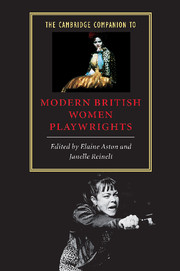Book contents
- Frontmatter
- 1 A century in view: from suffrage to the 1990s
- Part I Retrospectives
- Editors’ note
- 2 Women playwrights of the 1920s and 1930s
- 3 New plays and women’s voices in the 1950s
- 4 Women playwrights and the challenge of feminism in the 1970s
- Part II National tensions and intersections
- Part III The question of the canon
- Part IV The subject of identity
- Index
4 - Women playwrights and the challenge of feminism in the 1970s
from Part I - Retrospectives
Published online by Cambridge University Press: 28 May 2006
- Frontmatter
- 1 A century in view: from suffrage to the 1990s
- Part I Retrospectives
- Editors’ note
- 2 Women playwrights of the 1920s and 1930s
- 3 New plays and women’s voices in the 1950s
- 4 Women playwrights and the challenge of feminism in the 1970s
- Part II National tensions and intersections
- Part III The question of the canon
- Part IV The subject of identity
- Index
Summary
It is over thirty years since the most important change in British theatre this century took place: the abolition of censorship in 1968. Without that significant development, it is arguable whether this book could have been written. The changes in the relationship between feminism, theatre, and women playwrights since then were predicated on two phenomena: first, the rise of a new theatre movement, variously called 'alternative', 'fringe', or 'political', which exploded in the late 1960s and generated an energetic debate about the relationship between theatre, society, and politics; and second, the development of a vigorous feminist movement.
Controversial ideas about the relationship between art and society were being widely discussed at the time, and many of us argued for a transformation in the gender balance and perspectives of theatre. The theatre industry, we argued, was dominated by men; most directors and writers and stagehands were male, most casts (and therefore theatre companies) consisted of more men than women. The 'classical canon' of plays were written from a male-centred point of view, unthinkingly considered 'universal' and the 'norm'. The stage world was generally male-dominated - the action driven by, and seen from, the perspective of the male protagonists - as was journalistic reviewing and academic criticism.
- Type
- Chapter
- Information
- Publisher: Cambridge University PressPrint publication year: 2000
- 1
- Cited by



